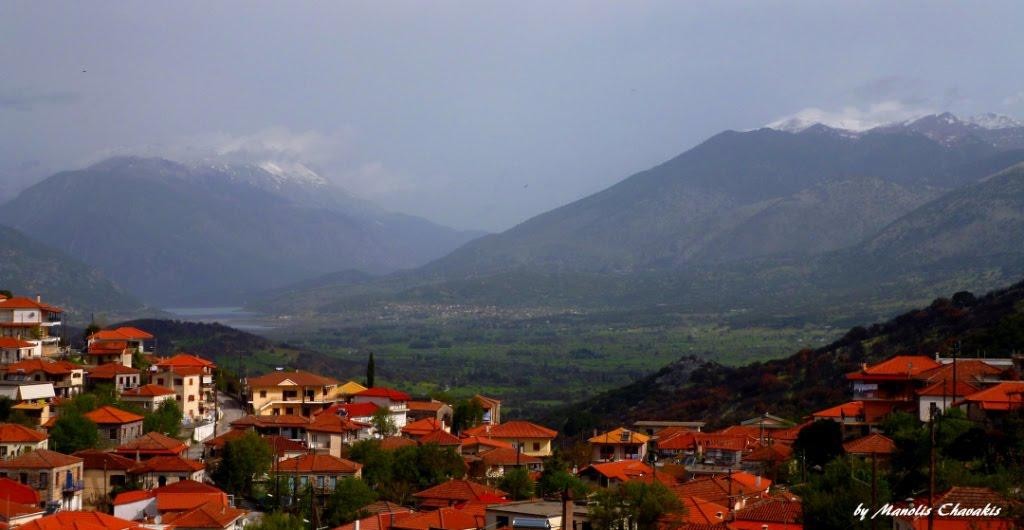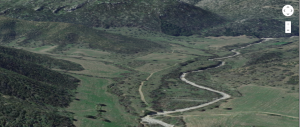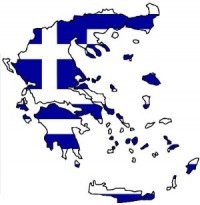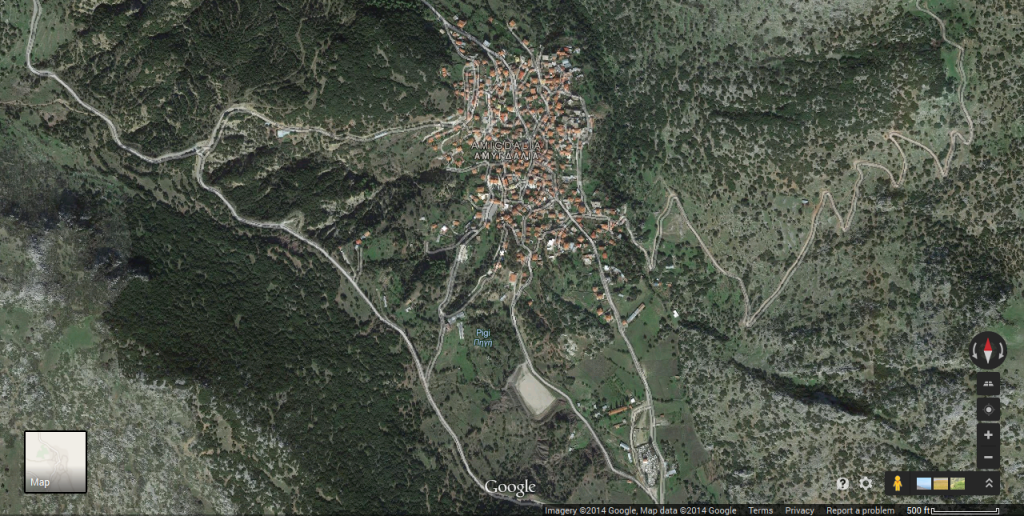(Take me straight to the photo album)
(Recent updates about the Greek family tree)
The Family Version: In the early 1800s, my grand-father’s ancestors lived in a coastal town called Messolongi, situated on the Gulf of Patra in Greece. In 1820s, during the war of Greek Independence against the Turkish Empire, my great-great-grandfather fled during the Battle of Messolongi into the Mount Parnassus region looking for a safer a place to settle. He came to a village situated on the slopes of Mount Parnassus called Plessas (Πλέσσα) in the Doridos region of Central Greece. He opened a business and eventually was able to buy several homes and shops in the village. 
What Might Have Really Happened. In the late 1700s, two men named “Kamoutsis” lived in or around Plessas. Where they came from, how long they lived there, and how they were related is unknown. Andreas Kamoutsis was born in 1777 and Stavros Kamoutsis was born 1795. Our family line descends from Andreas Kamoutsis.
What We Know Actually Happened. In the early 1900s, two of Andreas Kamoutis great-grandsons – my grand-father (John) and his brother (Peter) emigrated to the USA. We have photos of the Kamuchey family here, including a wedding photo of my Grandfather and Grandmother (John and Erna) and a photo of my Great-uncle Peter. The Kamuchey name is an American construct. In Greece the name is spelled KAMOYTEHE (ΚΑΜΟΥΤΣΗΣ) and it is pronounced Kamoutsis.
Village: The village was recognized as a town in 1912. In the 1920s, the village Plessas was renamed Amygdalia (ΑΜΥΓΔΑΛΙΑ or “Almond Tree”). The name “Plessas” may be based on a Slavic word “Plesso” which means “bald spot” or “area without a forest.” The village is characterized by its beautiful stone houses, the nice doorways, stone walls, narrow roads, the view to the lowlands, which is why the community is considered to still be very “traditional”. The village is now part of the Fokida or “Phocis” Prefecture (State) and is contained within the Lidoriki Municipality (County). History of the region can be found here, and an overview (translated from Greek) is here. Sample traditional costumes from Central Greece can be found here; ones from the Phocis region are here. An overview of the village can be found at the Greek version of Wikipedia (link takes you to an automatically translated version of the website).
Current demographical information about Amygdalia is here. The population is about 500, but tourism brings in more people during the summer.
And if you still want more history on the town, here is an archived copy of the town’s website (now offline) (in Greek; you may need to run the page through Google’s automatic translator).
A video slide show of the village can be viewed on Youtube here.
A Kamoutsis Kingdom? 
One family story is that the Kamoutsis clan once lived in a specific area north of Plessas, between Plessas and the village of Vralia (see the arrow above). The land sits on a flat area beside a river with two nearby valleys. and is known as Vathirema (Βαθύρεμα) which means “Deep River” or “Deep Creek’ (the river dries up in the summer from May to November). The tale says that the Kamoutsis families lived on the land until the time came to select a clan leader. One man was strong but dumb. The other was weak but clever. Because the families could not agree, they scattered and some went to Vralia and others to Plessas and others to the surrounding villages. There are two other towns in the area: Sotena and Malandrino. It is unclear if any Kamoutsis family members moved to those towns.


Back to the “Two Families” genealogy page
Updated 8/25/2017



When I asked our cousins about the Karnas & Baskutas families, they told me they were related. I think it was fairly common for early Greek-American settlers who were friends, to just call each other cousins.
The Karnas and the Baskutas are related. The mother of George and Nick Karnas (Karanasos) was Vasiliki Nicholas Kamoustis, a first cousin to Evangelos Ioannis Kamoutsis. Evangelos’ sister Paraskefy I. Kamoutsis married Stamatis J. Baskutas. So we’re 3rd-4th cousins.
Is it possible that a Nick Karnas moved to the U.S and had 2 children George and Stacey?
Thank you for your clearly-detailed explanation of the Doridos region and villages. I am researching my own family tree and came across your site because my paternal grandfather is from Vraila. Your explanation was very helpful to my understanding of the area.
Maria, what was your grandfather’s name? We’re working on a tree on Ancestry.com about Plessa Villagers Who Came To The US. We have a few Vraila names there as well.
Hello,
My name is Matt Karnas. I am one of the Minnesota side of the family. My Grandfather (died October 2016) is George James Karnas originally from Esko/Duluth, MN area. Please email if you’d like to try and piece together or fill in any gaps. I’ll do some digging and get some holes filled as best as possible.
Thanks for putting this together!
Update:
James George Karnas is my Great Grandfather. He had two kids – my Grandfather George James and a daughter Marguerite “Babe”. George had four kids: Kathy, James, Michael, and Darcy. There are nine grandchildren of George – Kathy (no kids), Jim (Chris, Emily, Aaron, and Andrew), Mike (Matt (me), Jim, and Luke), Darcy (Patrick and Danielle). Danielle has a daughter and I have have two sons (Leo and Edwin Karnas). Hope this helps anyone. Does anyone know of any other Karnas’ carrying on the last name?
Matt, I’ve emailed you, but there were several Karnas cousins who came to the US. Two were George Peter and Nick Peter (their mother was Vasiliki Kamoutsis their father was Peter George Karnas (Or rather Karanassos). Several of Peter George half brothers came to the US: Constatine “Charles” George, Efstathios “Steve” George, John George and James George. These uncles sponsored Peter George’s two sons when he was killed. Both George Peter and Nick Peter has children who still live in the US.
My Grand Father Evangelos Skiparnias and his brother Andreas came through Ellis Island and went straight to Deluth Minn to work on the railroad then moved to Chicago some years later they were form Plessa/Amigdalia
Angelo I ‘d love to chat further. I will email you this week.
My grandfather was originally from Plessa and it was great to see the info on the area!
You’re welcome. Feel free to contact us if you have questions